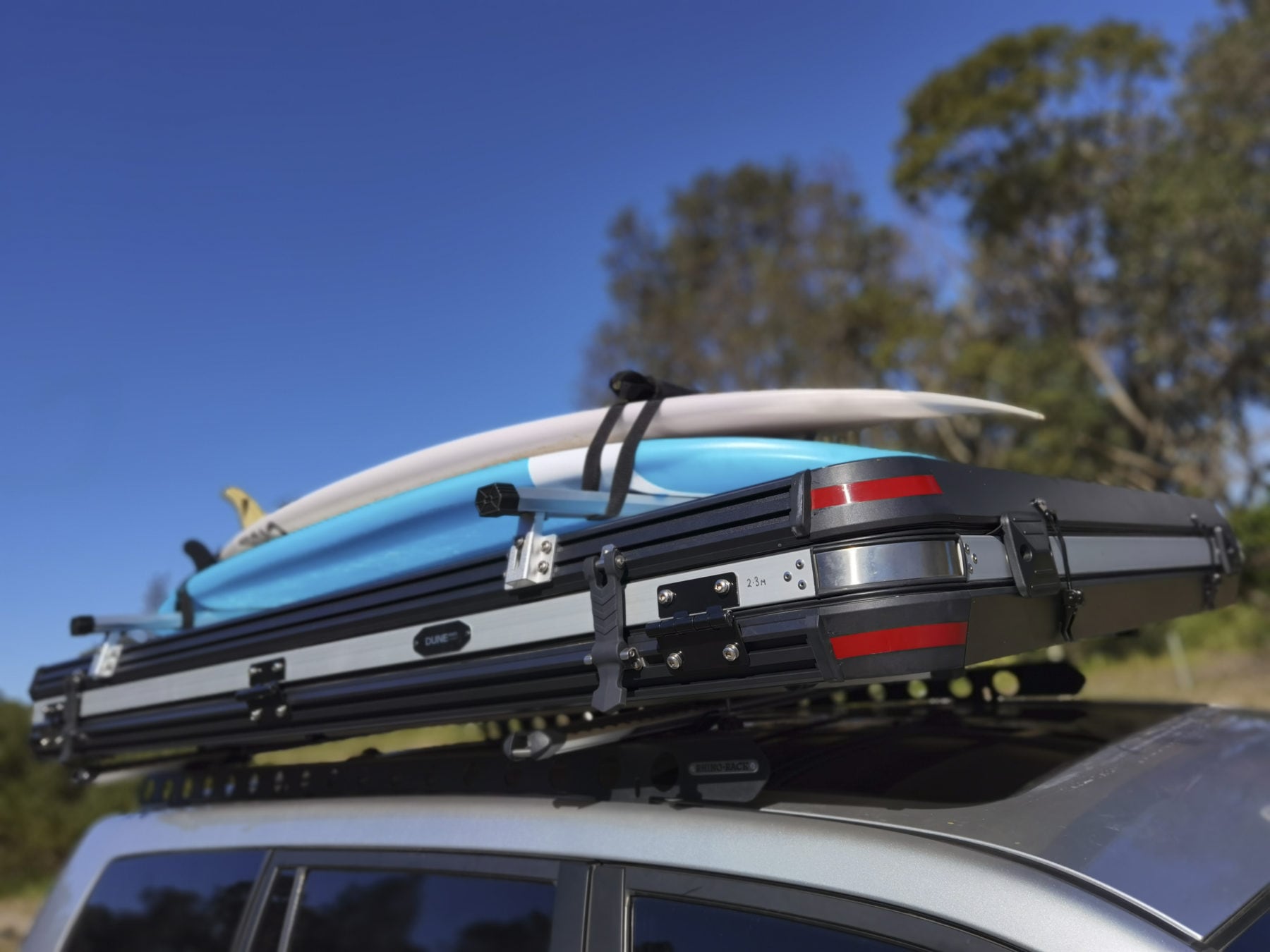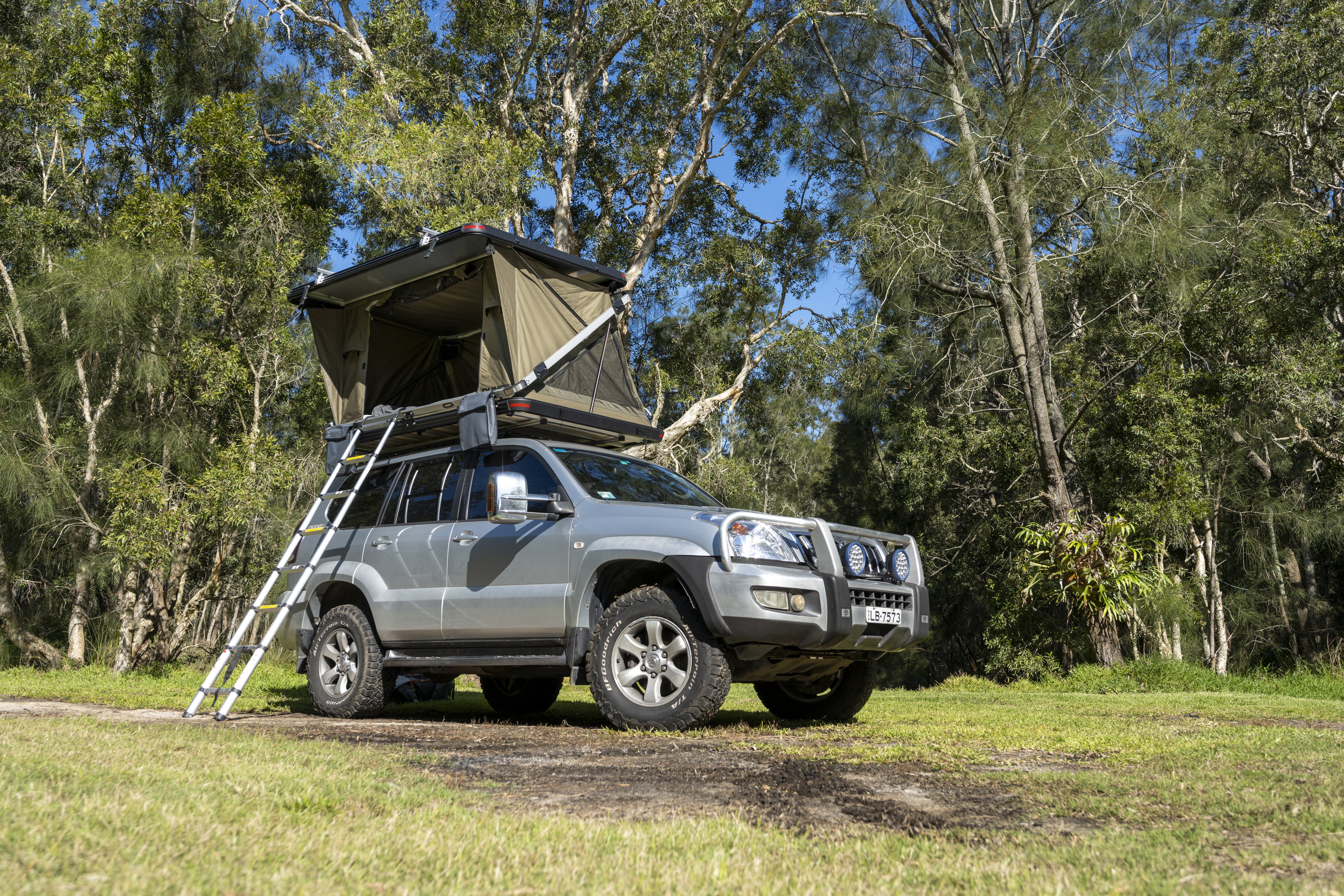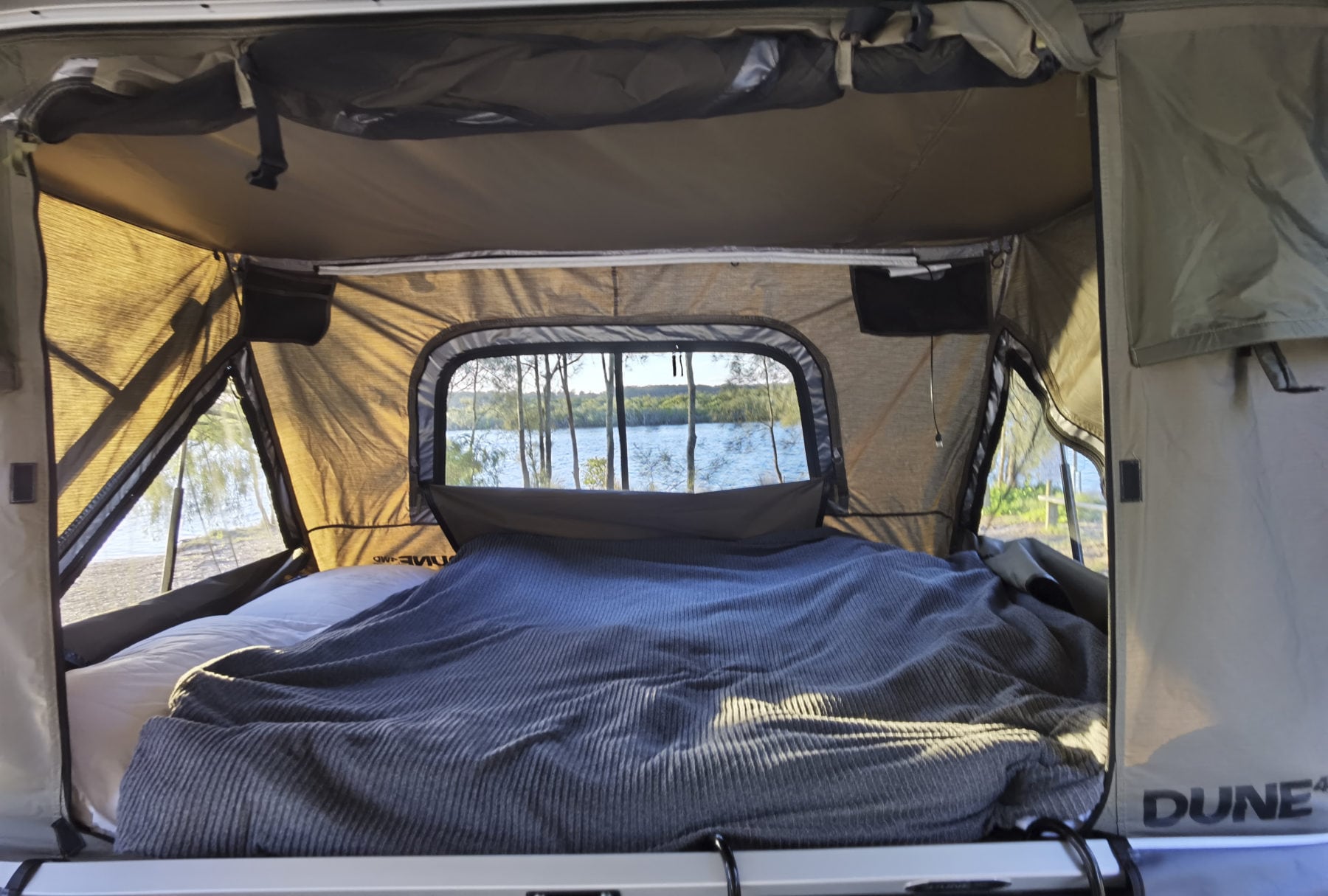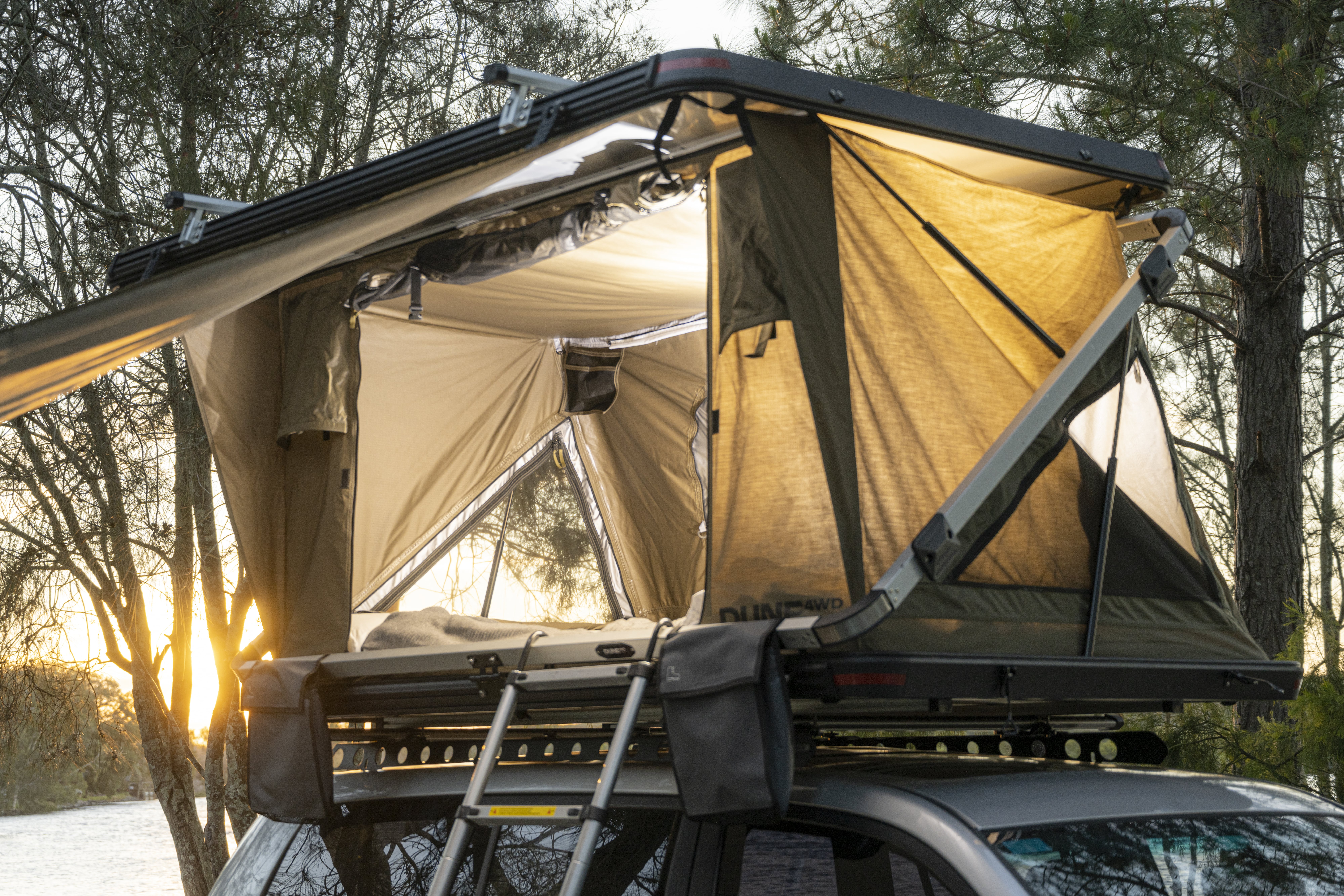Originating in the African continent (think: large carnivores, camping and wanting to stay above ground to lessen the chance of becoming a meal for a large cat) rooftop tents have become more and more popular in Australia over the past decade or so. Their appeal is thanks to a number of unique features, such as the fact you are sleeping off the ground, you can leave all your sleeping gear in them when packing up, you instantly free up some cargo space inside your vehicle, and they are very quick to set up – especially if there is only two of you, or even for a small family. Enter the Dune Desert Cruiser rooftop tent, a tent that is a tad different – and innovative – compared to the usual run-of-the-mill full canvas variant. You see, this one has a very hard head…
Design
The Dune Desert Cruiser rooftop tent features over-engineered construction and a hard roof, rather than the more common canvas type seen on rooftop tents. This is great news for a few reasons. The first is that if it does rain, when you eventually pack up, you won’t be dropping a wet slab of canvas on top of your bedding. The second is that Dune has designed its seriously tough roof to also be fitted with roof racks, allowing you to load up lighter equipment, such as surfboards, sleeping gear, etc.

The hard-shell rooftop does not add much height to the overall tent, but it does add considerable weight, hitting the scales at 94kg. Also contributing to its heft is the hydraulic arms that help raise and lower the tent, along with the (very comfy) 50mm high-density foam mattress, the fly and floor material (robust and waterproof 190g poly/cotton Oxford canvas) and the telescopic aluminium ladder (weight rating of 150kg).
There’s no doubt this thing is built tough (its internal weight capacity is 300kg) but it does contribute to that notable heft. Speaking of which, before purchase, it’s worth checking your vehicle’s legal roof load capacity; you will also need to add in the weight of your actual roof-racks that the tent will sit on and be sure the total doesn’t exceed your limit as it is both illegal and dangerous.
The over-engineering of the tent continues with robust rubber hook clamps (with steel tab inserts) on the two longer sides that stretch down and over into a clamp, beefy hinges, more metal clamps on each end, and a very solid base. In short, if you want a near indestructible rooftop tent, the Dune Desert Cruiser puts forward a very solid case (excuse the pun). Attaching this home away from home to your roof is via roof-bars, and we’d suggest heavy-duty ones. The four clamps attach via long bolts and threaded nylon nuts that you hand-tighten. Note that this tent will not fit on some of the increasingly popular roof platforms now available as the clamps are not wide enough to fit around the rails on the platforms and, in the case of north-south rails , it won’t fit either, as the clamps are oriented for east-west (cross) bars only. It will fit easily on all roof-bars, however, and is actually quite quick to fit.
The tent’s interior dimensions are 2050mm long, 1390mm wide and 1000mm tall, which makes the case for potentially fitting two adults and one small child in there. There;s also two are two big canvas shoe bags – actually handy – and a LED lighting system, along with zipped mesh windows and smaller vents. The exterior packed dimensions are 2210mm x 1550mm x 250mm. It comes with a two-year warranty.
In the field with the Dune Desert Cruiser
Our initial test was at a beachside camp. Here, with a relatively flat surface (one of the musts for camping in a rooftop tent; you don’t want to sleep on an angle), the appeal is obvious: from parking, to climbing the ladder to bed was three minutes. Unclipping the clamps and tie-downs is quick and then you just push up on the front door side of the tent, and then push the aluminium frame up on the opposite side, (which is also assisted by hydraulic arms) and the tent is fully erect. Then, just reach in, grab the ladder and you’re in. The hydraulic arms are beefy and promise years of reliable operation during the setting up process. All the clamps are robust and tight enough that you won’t have to worry about the tent flying up during driving.

We found the telescopic ladder to flex a bit – even under the weight of a 95kg tester – so we would advise beefier folk to take it easy when ascending it. It is rated to 150kg, but just to be on the safe side, don’t rush.
Inside, the large rear window is great for promoting air circulation, in combo with the two triangular size winds, plus the two covered vents near the door. Speaking of air, there was one issue with the tent when in motion; wind buffeted the base of it – a series of cross-bars that brace the bed – and it was noisy in transit. Whether it was air getting into the tent interior (the mattress sits on those cross-bars) and echoing around that hollow space, or those cross-bars were vibrating to cause the noise, or it was the particular set-up on the Prado roof-platform system, we couldn’t figure out. We added a sheet of ply under the mattress and the noise did disappear. Not an ideal solution, so we’ll investigate further.
Packing up the Dune Desert Cruiser was as easy as setting up, with the procedure simply done in reverse. This can be handy as one of the slight negatives of a rooftop tent is, if you have set up camp but then need to drive somewhere, you have to pack the tent up again. It isn’t too arduous, though. The handy strap affixed inside the tent helps you initially drop the roof down, then you just have to compress the ladder and put it inside, and make sure all the wall material is tucked in before locking down all the clamps.

For a family of four, don’t discount this rooftop tent: there is an accessory annexe that adds enough space for two camp beds inside, plus there’s also a separate exterior awning (used during testing) that can be added for even more shelter. The awning adds a considerable amount of shelter and connects quickly to the tent via zips. Plus, you can store it in the tent.
The final word
The Dune Desert Cruiser rooftop tent is very well built. It offers that luxury of a hard-shell roof, along with a clever and fast set-up system, plus impressive interior space. The added versatility of the roof racks being able to be fitted above the roof is excellent, but the caveat here is you need to be sure any additional gear – much less the tent itself – doesn’t exceed your vehicle’s legal roof load limit. Weighing in at 95kg, this tent is heavy compared to others in its class. Check the roof load limit on your 4WD; you may be surprised how little some of the ‘big’ models can carry on their roof.

If it does fit on your vehicle’s roof, it’s hard to fault its versatile and practical design – and its ease of operation. You do pay a premium compared to an all-canvas/cotton equivalent, but we reckon it is worth it. And a final note on that huge hard-top roof: we reckon it’d be perfect for attaching a flexible solar panel to. Just sayin’…
RRP: $3999.99 (Anaconda club member price: $1999) Available at Anaconda


